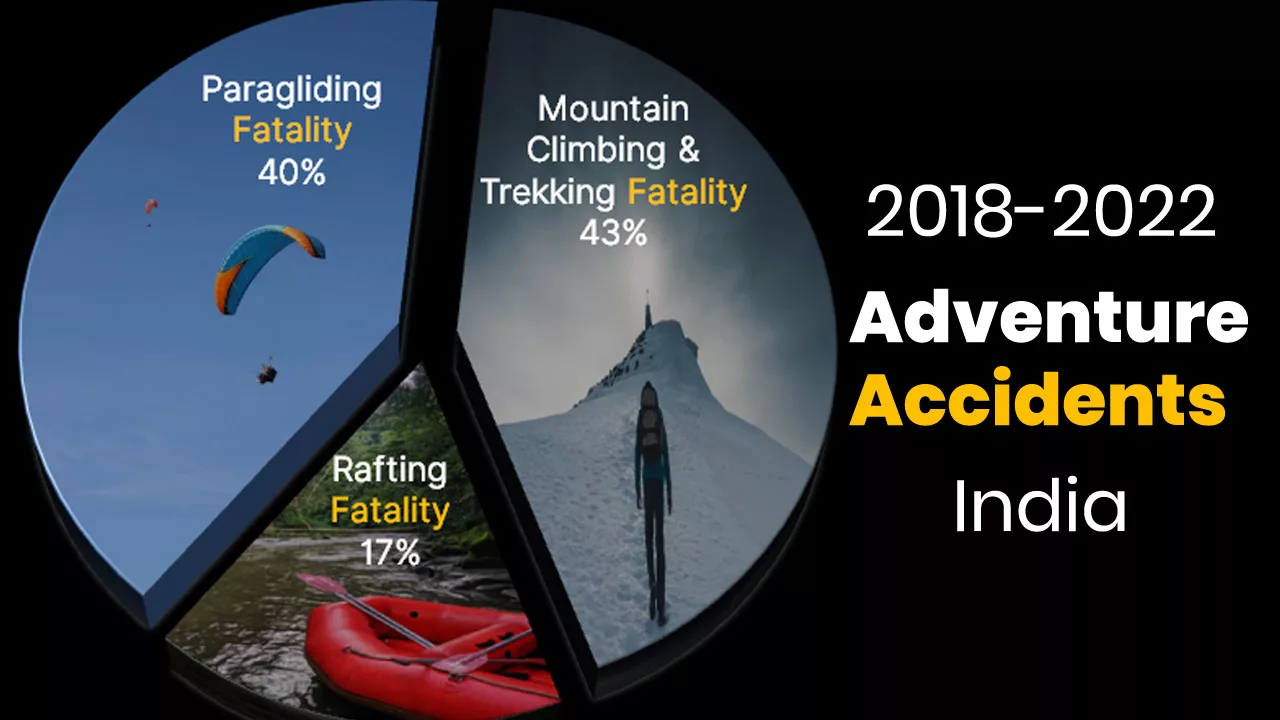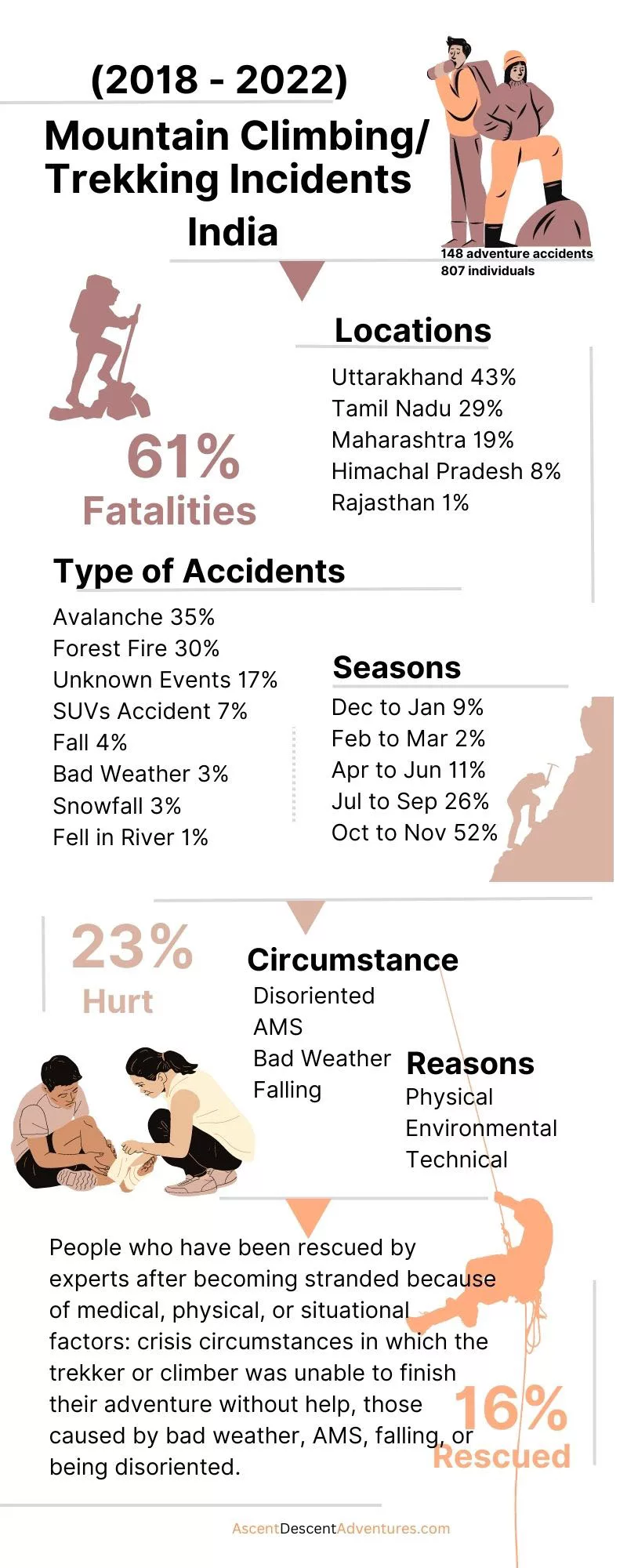Understanding Adventure Sports Accidents India
Indian Himalayas
Since 2010, Ascent Descent Adventures has been associated with mountain adventure and safety. Accidents may happen to anybody, and anything can go wrong in the mountains. Therefore, to understand adventure Sports Accidents in India and what goes wrong when engaging in adventure activities. We researched adventure accidents that occurred in the previous five years (2018-2022). The long-term goal is to enhance prevention.
We acquired data on adventure accidents in India and Indian Himalayas, from the Times of India newspaper. Other sources of data are unavailable due to a lack of exact information and communication.
Fatalities, Hurt, and Rescue:
The exploded doughnut graph depicts Mountain Climbing/Trekking, Rafting, and Paragliding incidences in India during the previous five years, along with the percentage of fatalities, injuries, and rescues.

Aim:
- The initial goal of this study was to improve our understanding of the intrinsic dangers associated with trekking, climbing, and other adventure sports, and to establish effective risk management, approaches based on evidence.
- The second goal was to translate the core research findings into preventive suggestions for trekkers, climbers, and outdoor enthusiasts.

Overall, the data emphasize the need to take care and according to safety recommendations when participating in mountain climbing and trekking activities to reduce the risk of accidents and incidents. It also underlines the need for successful search and rescue efforts in locating missing people and ensuring their safe return.
Frequent Accident Occurrences
The research’s purpose is to identify occurrences connected to adventure activities.
Accidents that Reoccur
To have a deeper understanding of the adventure mishaps.
To Discover Risk Prevention Methods
This research is a tool for learning and reflecting on prior occurrences that we are only beginning to use. To get a clearer understanding of the function of conscious participation in a high-risk environment. Accidents frequently occur among skilled mountaineers who can assess the dangers they are committing.
Our research has allowed us to discover the repeating scenarios that lead to accidents in trekking, climbing, and other adventure sports, as well as the contributing components to an accident situation. The study has also highlighted the many risks associated with adventure sports.

Analysis of Adventure Sports Accidents in India: A 5-Year Study
A synopsis of the research conclusions can be found here, and they are partially discussed below.
Abstract:
Adventure sports and activities have become increasingly popular in India over the years, attracting both domestic and international enthusiasts. However, with this increase in popularity comes a rise in accidents and fatalities associated with these activities. Data gathered over the past five years shows that mountain climbing and trekking accidents occur at a rate of 43%. While rafting and paragliding accidents occur at a rate of 57%.
Trekking, Rafting, Paragliding – Adventure Sports Accidents
Among these activities, mountain climbing and trekking have the highest percentage of deaths at 61%, followed by paragliding accidents at 58%, and rafting accidents at 24%. The data also indicates that most paragliding accidents are due to crash landings and equipment failure. While environmental, human, and physical factors contribute to mountain climbing and trekking deaths. Rafting deaths, on the other hand, are mostly due to raft capsizing.
Missing and Found Climbing and Trekking – Adventure Accidents
In terms of missing and found individuals during mountain climbing and trekking, Uttarakhand and Himachal Pradesh have the highest percentage, with 53% and 25% missing individuals respectively. However, percentage-wise, the highest number of missing individuals were found in Himachal Pradesh and Uttarakhand border combined, at 10%.
Risk prevention
The data suggests that adventure sports and activities have inherent risks that need to be carefully considered and addressed. Professional adventure sports organizations and individuals must accept and assign value to the risks associated with these activities. And take appropriate measures to prevent accidents. Risk prevention recommendations include adequate training and certification, appropriate gear, and equipment. Following mountain safety and safety protocols, and considering weather and environmental conditions.
While adventure sports and activities can be exhilarating and rewarding experiences, they also pose significant risks that should not be taken lightly. With proper precautions, the use of contemporary mountaineering technology, risk prevention measures, and mountain education adventure enthusiasts can continue to enjoy these activities safely.
Adventure Sports Accidents – In Nutshell
In conclusion, accidents do occur during mountain climbing and trekking expeditions on various routes across India. It is essential to approach these activities with caution and proper preparation. The data provided sheds light on the routes where accidents have been reported, emphasizing the need for awareness and safety measures.
Informed Decisions
By analyzing this data, climbers, and trekkers can make informed decisions about their routes and take necessary precautions to mitigate risks. It is crucial to stay updated with the latest safety guidelines and equip oneself with appropriate gear. And undergo proper training before embarking on these adventures.
Furthermore, it is important to note that accidents are relatively rare compared to the number of individuals who participate in these activities. With proper planning, guidance, and adherence to safety protocols, the vast majority of adventurers can enjoy their experiences without incident.
Use this Study
Adventure companies, tourism boards, and authorities can use this study to identify areas with higher accident rates and implement strategies to improve safety measures. This can include better signage, well-maintained trails, and comprehensive emergency response systems.
Minimizing the Risks
Overall, while the data reveals instances of accidents, it should not discourage individuals from exploring breathtaking landscapes and engaging in thrilling outdoor activities. By respecting nature, being prepared, and promoting responsible adventure tourism. We can ensure that these activities continue to bring joy, personal growth, and unforgettable experiences while minimizing the risks associated with them.
Remember, adventure is out there, and with the right mindset and precautions, it can be pursued safely. Allowing us to create lifelong memories and forge a deeper connection with the natural wonders that India has to offer.